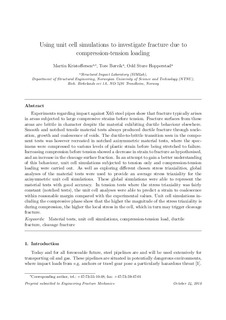| dc.contributor.author | Kristoffersen, Martin | |
| dc.contributor.author | Børvik, Tore | |
| dc.contributor.author | Hopperstad, Odd Sture | |
| dc.date.accessioned | 2017-09-21T06:56:29Z | |
| dc.date.available | 2017-09-21T06:56:29Z | |
| dc.date.created | 2016-08-09T11:24:19Z | |
| dc.date.issued | 2016 | |
| dc.identifier.citation | Engineering Fracture Mechanics. 2016, 162 269-289. | nb_NO |
| dc.identifier.issn | 0013-7944 | |
| dc.identifier.uri | http://hdl.handle.net/11250/2455873 | |
| dc.description.abstract | Experiments regarding impact against X65 steel pipes show that fracture typically arises in areas subjected to large compressive strains before tension. Fracture surfaces from these areas are brittle in character despite the material exhibiting ductile behaviour elsewhere. Smooth and notched tensile material tests always produced ductile fracture through nucleation, growth and coalescence of voids. The ductile-to-brittle transition seen in the component tests was however recreated in notched axisymmetric material tests, where the specimens were compressed to various levels of plastic strain before being stretched to failure. Increasing compression before tension showed a decrease in strain to fracture as hypothesised, and an increase in the cleavage surface fraction. In an attempt to gain a better understanding of this behaviour, unit cell simulations subjected to tension only and compression–tension loading were carried out. As well as exploring different chosen stress triaxialities, global analyses of the material tests were used to provide an average stress triaxiality for the axisymmetric unit cell simulations. These global simulations were able to represent the material tests with good accuracy. In tension tests where the stress triaxiality was fairly constant (notched tests), the unit cell analyses were able to predict a strain to coalescence within reasonable margin compared with the experimental values. Unit cell simulations including the compressive phase show that the higher the magnitude of the stress triaxiality is during compression, the higher the local stress in the cell, which in turn may trigger cleavage fracture. | nb_NO |
| dc.language.iso | eng | nb_NO |
| dc.publisher | Elsevier | nb_NO |
| dc.rights | Attribution-NonCommercial-NoDerivatives 4.0 Internasjonal | * |
| dc.rights.uri | http://creativecommons.org/licenses/by-nc-nd/4.0/deed.no | * |
| dc.title | Using unit cell simulations to investigate fracture due to compression-tension loading | nb_NO |
| dc.type | Journal article | nb_NO |
| dc.type | Peer reviewed | nb_NO |
| dc.description.version | acceptedVersion | nb_NO |
| dc.source.pagenumber | 269-289 | nb_NO |
| dc.source.volume | 162 | nb_NO |
| dc.source.journal | Engineering Fracture Mechanics | nb_NO |
| dc.identifier.doi | 10.1016/j.engfracmech.2016.04.044 | |
| dc.identifier.cristin | 1371390 | |
| dc.relation.project | Norges forskningsråd: 237885 | nb_NO |
| dc.description.localcode | This is the authors' accepted manuscript to the article. Locked until 14 May 2018 due to copyright restrictions. | nb_NO |
| cristin.unitcode | 194,64,45,0 | |
| cristin.unitname | Institutt for konstruksjonsteknikk | |
| cristin.ispublished | true | |
| cristin.fulltext | postprint | |
| cristin.qualitycode | 2 | |

